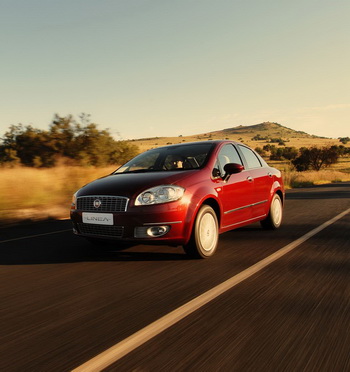 |
|
Fiat India, which has been boosted this year
by the reception two key new models, the
Linea (above) and Grande Punto, has revealed
that it expects to end the year with around
23,000 sales and next year it is ambitiously
targeting doubling this number. |
|
|
|
Fiat India,
which has been boosted this year by the reception two
key new models, the Linea and Grande Punto, has revealed
that it expects to end the year with around 23,000 sales
and next year it is ambitiously targeting doubling this
number. Fiat India Automobiles is a 50-50 split joint
venture with Tata Motors and Fiat Group Automobiles and
operates a state-of-the-art production facility at
Ranjangaon in Pune where all three of its models are
assembled.
"Next year, we are planning to double this
year's numbers. We hope to end the current year with around
23,000 Fiat-branded vehicles," Fiat India Automobiles CEO
Rajeev Kapoor said
yesterday, adding that the company has sold 20,000 cars so
far this year.
Born out of the
ashes of Fiat's last unsuccessful foray into India, Fiat
India Automobiles operates the former Fiat factory at
Ranjangaon in Pune. This state-of-the-art facility has the
capacity to produce 200,000 vehicles per year, as well as
engines and transmissions. The Linea started to roll off the
Ranjangaon production lines at the beginning of the year to
strong local market acclaim, pushing forward Fiat India's
rebirth, and it has been joined this summer by the Grande
Punto in 5-door format, which also looks set for a strong
future in India. The factory is expected to build cars for
Tata Motors as well as future Fiat models and recently it
was announced that the R&D headcount would be doubled. Fiat
India has plans to develop its own models and is currently
evaluating ambitious projects including breaking into the
growing 600cc market segment.
Kapoor believes
that the passenger car market in India will see double digit
growth next year and he foresees than new versions of the
existing range, including a bigger engine for the Linea, can
push sales through the 50,000 barrier next year. Fiat India
is also aggressively targeting exports of it model
production, with the Linea and Palio already being shipped
to South Africa, and it is also aiming to push the range
into its adjoining markets. "We are working on neighbouring
countries like Nepal and Bhutan," said Kapoor. "We are
already in discussion with the dealers in these countries."
This export
drive perfectly fits with the strategy of the Fiat Group
which has long eyed making India one of its major global
manufacturing hubs, and with its Ranjangaon factory now
producing the Grande Punto and Linea as well as the Palio,
all of which feature very high levels of local component
content it has the core of models to fulfil these ambitions.
With Fiat's repeated failure to tap into the explosive
growth being seen in the Chinese new car market, India
represents a key global growth market. Last year Fiat India
exported just 800 cars, all of which were the B-segment
Palio hatchback and shipped to South Africa.
Kapoor also narrowed the
India launch date of the new low cost B-segment "Uno" to the
second half of 2011. Previously he has said it would arrive
sometime in 2011.
This car is being engineered primarily by Fiat Automóveis in
Brazil with design in conjunction with Fiat Centro Stile in
Turin and its 'upright' styling theme takes its key cues
primarily from the Fiat Panda as well as drawing on the
acclaimed looks of the Grande Punto. Fiat India's Ranjangaon
factory will be one of several global manufacturing hubs
scheduled to turn out this new model as the Italian carmaker
prepares the ground for a second "Project World Car" family
to replace the ageing Palio hatchback and its series of
derivatives. The current Palio is also built in Ranjangaon
and sold across India, and features a recent local-market
specific facelift. As well as Brazilian and Indian
production locations, the new "Uno" is proposed for the
Zastava factory in Serbia.
|